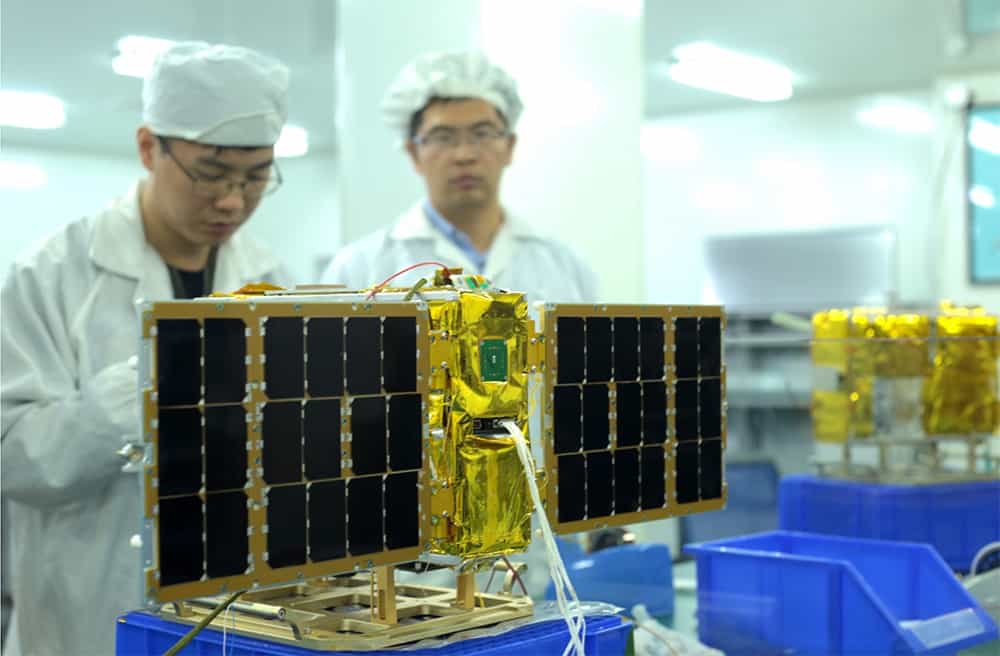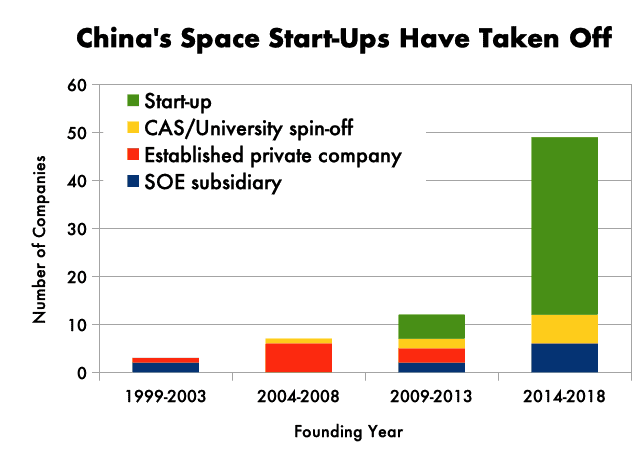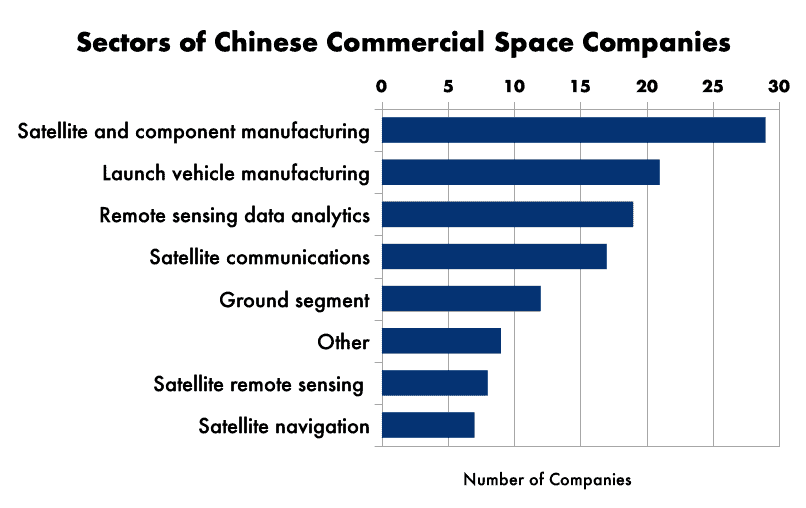
Credit: Spacety press release
All eyes have been on China’s successful launch of Mars mission Tianwen-1. The spacecraft and the rocket that launched it, like most of the technology for China’s national space missions, was made by China Aerospace Science and Technology Corporation (CASC), the state-owned enterprise that holds the main contracts for China’s space program.
But, in recent years, new opportunities have emerged in China’s private space sector. This week we look at the recent rise of commercial space companies in China.
The Rise of China’s Commercial Space Sector

In 2014, a change in government policy, part of a financial document known as Document 60, spurred the growth of China’s commercial space sector, especially in launch and remote sensing. The change incentivized private investors to fund commercial space ventures, and the number of Chinese space startups has taken off since.
A report by the Institute for Defense Analyses’s Science and Technology Policy Institute (STPI) compiled a list of 78 wholly or partially private Chinese space companies established since 1986. Most of these companies, and all of the start-ups, were established in the past ten years.
Private venture capital firms made up 65 percent of last year’s investors in Chinese space companies, according to Bryce Space and Technology, an analytics and engineering firm. Provincial and municipal VC firms also play a role in financing space companies to encourage high-tech development in their regions.
| Investors in China’s Commercial Space Companies | |
|---|---|
| Private companies and VC firms | Matrix Partners China, Horizons Ventures, Shunwei Capital, K2VC, Legend Capital, Essential Capital, Galaxy Holdings Group, Alibaba |
| Private individuals |
Company founders, e.g. LandSpace’s Zhang Changwu (16%) and ZeroG Lab’s Lan Lidong (56%)
Angel investors, often undisclosed, e.g. Niu Wen, investor in LandSpace and MinoSpace
|
| Provincial and municipal VC firms | Beijing E-Town, Jilin province asset management firm, Changchun municipality venture capital |
| State-owned enterprises | CASC’s Aerospace Investment Holdings Company, CASIC’s Sanjiang Space Group, Guochuang Investment Guidance Fund (established by CASC and Chinese banks) |
| CAS institutes and universities | CAS Changchun Institute of Optics, Fine Mechanics, and Physics; CAS Center for Space Applications on Engineering and Technology; The Harbin Institute of Technology Robot Group; Tsinghua University |
Data: STPI, Pitchbook, Bryce Space and Technology, company filings
Since a number of companies in the sector were spun out of state-owned enterprises, universities or institutes of the Chinese Academy of Sciences (CAS), these organizations often retain some ownership in the ventures.
The government also allows commercial space companies to use its resources and supply chains. Commercial launches often take place at the government’s Jiuquan Satellite Launch Center, and CASC and the China Aerospace Science & Industry Corporation (CASIC) — both SOEs — have launched satellites for commercial companies aboard their rockets.
However, STPI notes, space company founders are often motivated more by “expectations of economic payoff and interest in space” than by patriotism or government policies. The founders see economic potential in commercial space activities and inspiration in Western founders like Elon Musk. Some founders are also motivated by the opportunity for more freedom to develop their own technologies than they had working in SOEs like CASC.
But It’s Far Behind the U.S.’s Commercial Space Sector

China’s commercial space sector is growing, but it is dwarfed by the U.S. commercial space sector in both number of companies receiving funds and in funding amounts, according to data from Bryce.
The vast gap last year in investment between American and Chinese space companies is largely due to big investments in a small handful of U.S. companies, including SpaceX, OneWeb1Bryce considers OneWeb funding to be investment in the U.S., since the majority of OneWeb’s activities are in the U.S. and Blue Origin. These three companies together received $3.15 billion in investment last year, according to Bryce.
The two SOEs mainly responsible for China’s national space program, CASC and CASIC, are also much larger than any of China’s commercial space companies. The two reported revenues of more than $37 billion each in 2018, according to Defense News.
China’s space industry is hampered by U.S. and other western countries’ export controls, which prohibit cutting edge technologies from the West from being used in China. The U.S. government has strict regulations around the export to China of technologies used to build, launch, and operate satellites, amounting to a “complete embargo,” according to Kevin Wolf, who led the export controls program at the Commerce Department’s Bureau of Industry and Security during the Obama administration.
The U.S. bans these exports because there’s a “significant risk of diversion” of satellite technology for military uses, even if an export is intended for commercial use.
However, according to STPI, lack of access to foreign technology has also spurred China to advance its domestic space technologies, in contrast to some other high-tech industries, such as chipmaking, where its domestic capabilities are further behind.
It’s Largely Confined to Small Satellites and Earth Observation

According to STPI, China’s commercial space industry focuses on the manufacturing, launch and use (including data analytics) of small satellites — defined as satellites under 500 kg.
The companies mostly serve Chinese customers such as other companies in the industry, universities, and some government organizations (such as CCTV), though they do count a few foreign companies as clients.
Chinese Commercial Space Companies
| Company | Category | Investment | What They Do |
|---|---|---|---|
| LandSpace | Start-up | Country Garden invested $71m in Series C funding Dec. 10, 2019. The company raised another $14m from Yisheng Investment, Luxin Venture Capital and others earlier in 2019. | One of China’s biggest private launch companies, with OneSpace and iSpace. Among the most ambitious of the private launch companies, it was the first to attempt orbital launch, it hopes to build medium-lift launch vehicles, and it has contracts with foreign customers as well as domestic small satellite customers. |
| OneSpace | Start-up | CICC led Series B fundraising of $44m on Aug. 13, 2018. Previously, the company raised $31m in Series A+ funding, led by Qianhai Wutong Mergers and Acquisition Funds in Jan. 2018. | One of the handful of private Chinese companies to have attempted orbital launch. The company’s customers include Chinese companies ZeroG Lab and Spacety and state-owned enterprise AVIC. |
| iSpace | Start-up | Series A+ and A++ investors include Ward Rongjin Investment Holdings, Jinggang Hezhong Energy Technology, CDH Investments, Galaxy Holdings and Matrix Partners China. The company has raised more than $100m to date. | Became first private Chinese company to send a rocket into orbit in July 2019, after failed attempts by LandSpace and OneSpace. The launch carried satellites for CASIC and Beijing Institute of Technology and a classified military research payload. The company’s customers have also included Chinese companies ADA Space and ZeroG Lab. |
| Expace/CASIC Rocket Technology Company | SOE subsidiary | The company is a subsidiary of CASIC. It has raised at least $171m to date. | Commercial rocket division of CASIC. Successfully launched both commercial and government satellites into orbit on Kuaizhou series of rockets. |
| Galactic Energy | Start-up | Puhua Capital led $21m funding round Oct. 1, 2019. Amphora Capital China, Kexin Capital (Xizang) and Scheme Capital invested $14m April 12, 2019. | First launch of Ceres 1 rocket planned for 2020. Also developing Pallas rocket, planned to launch in 2022. |
| Qianxun Spatial Intelligence | Start-up | ICBC, China Reform Holdings, and Shanghai Int’l Group led $141m Series A funding Oct. 18, 2019. The company was established in 2015 as a joint venture between Alibaba and state defense contractor Norinco. | Provides high-precision (centimeter and millimeter) positioning services for Internet of Things applications using data from GPS, Beidou, and other satellite constellations. Has partnered with companies like Qualcomm and Quectel and u-blox to provide services for navigation, self-driving cars, drones, bikes, and more in China. |
| Commsat | Start-up | AVIC Capital and Beijing Wealth Capital led Series B funding of $38m May 13, 2020. | Commsat is a service provider for the small satellite industry. The company has launched eight satellites and it is building a satellite production line in Tangshan that aims to produce 100 satellites a year. It is also working on satellite applications in the logistics and ocean transportation industries. |
| Spacety | CAS/university spin-off | Legend Capital led Series B round of $22.2 million July 20, 2018. Galaxy Holdings, K2VC, Maintrend Capital, and Matrix Partners China also participated in the round. | The company builds micro- and nano-sized satellites, aiming to lower the cost and time to produce these satellites for commercial and research uses. According to their website, they have launched 18 cubesats and have 50 business users. |
| Chang Guang Satellite Technology (also known as Charming Globe) | CAS/university spin-off | The company raised $35m from angel investors Oct. 1, 2018. Previously, the company raised an undisclosed amount of venture funding from Zhongji Jintai in 2017. The company also received an investment from Jilin province’s fund for SMEs in 2014 and one of its earliest investors is the CAS Changchun Institute of Optics, Fine Mechanics, and Physics. | Manufactures remote sensing satellites. The company’s core project is the Jilin-1 satellite constellation. The company hopes to finish launching 138 satellites by 2030, and these satellites will provide remote sensing data to many different industries. Expace has launched some of Chang Guang’s satellites. |
| Zhuhai Orbita | Established private company | The company has traded on the Shenzhen Stock Exchange (300053.SZ) since 2010. It is at least 15% state-owned. | Established in the early 2000s as a satellite manufacturer for the government, Orbita now has plans to build a large low earth orbit satellite constellation. The company also provides remote sensing data and analytics to customers in many areas, including city management, surveying and mapping, security, and more. |
| ZeroG Lab | Start-up | Guangzhou Fund led venture funding of RMB tens of millions Jan. 22, 2020. Huaxun Fangzhou and other undisclosed investors also participated in the round. | The company manufactures micro- and nano-satellites and their hardware and software components. |
| Jiahe Info | Start-up | Junsan Capital led Series A+ funding round of RMB tens of millions Aug. 30, 2019. Wuhan Optics Valley Elite Investment Management also participated in the round. Previous investors include CASH Capital. | The company uses remote sensing to monitor crops and soil conditions for agricultural enterprises and provides data to agricultural insurance companies to allow the companies to quickly assess damages from natural disasters. |
Data: STPI, Pitchbook, company websites, press releases

Emma Bingham is a Boston-based editor for The Wire. Previously, she was editor in chief of The Tech at the Massachusetts Institute of Technology. @emmapbingham



